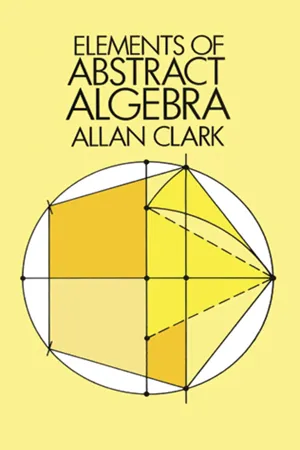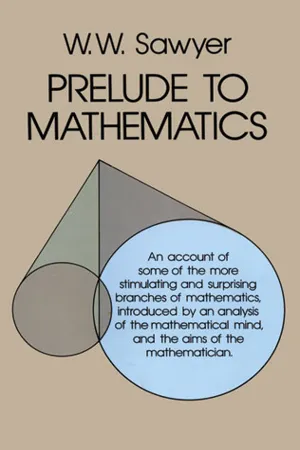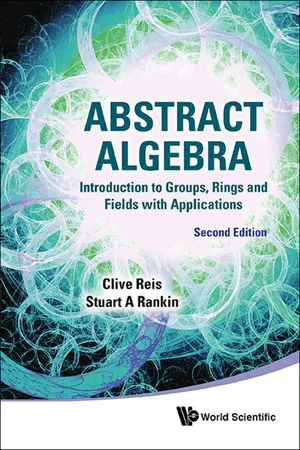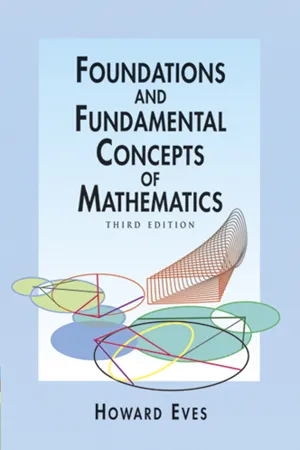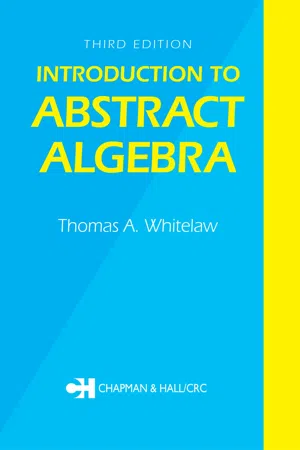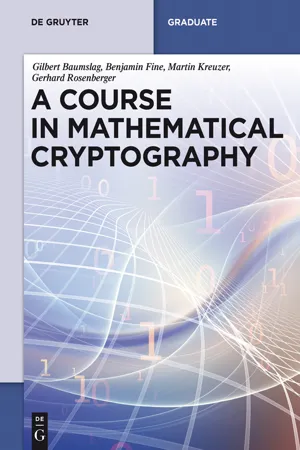Mathematics
Group Mathematics
Group Mathematics is a branch of abstract algebra that studies the properties of groups, which are sets of elements that can be combined using a binary operation. It explores the structure and symmetry of groups, and their applications in various fields such as physics, chemistry, and computer science.
Written by Perlego with AI-assistance
9 Key excerpts on "Group Mathematics"
- eBook - ePub
- Allan Clark(Author)
- 2012(Publication Date)
- Dover Publications(Publisher)
Chapter 2Group Theory
The theory of groups is the proper place to begin the study of abstract algebra. Not only were groups the first algebraic structures to be characterized axiomatically and developed systematically from an abstract point of view, but more important, the concept of group structure is basic to the development of more complex abstractions such as rings and fields. Furthermore, group theory has an enormous number of applications to many diverse areas of mathematics and physics. Hardly any other area of mathematics can match the theory of groups in elegance and usefulness.This chapter is an exposition of the elementary theory of groups with emphasis on groups of finite order. Three advanced topics (the Sylow theorems, the Jordan-Holder theorem, and simplicity of alternating groups) are included for applications and depth.The Definition of Group Structure
26. A group is a set G with an operation (called the group product ) which associates to each ordered pair (a , b ) of elements of G an element ab of G in such a way that:- for any elements a , b , c ∈ G , (ab )c = a (bc ) ;
- there is a unique element e ∈ G such that ea = a = ae for any element a ∈ G ;
- for each a ∈ G there is an element a −1 ∈ G such that a −1 a = e = aa −1 .
To be precise a group product should be viewed as a mapping μ : G × G → G , and the group should be denoted (G , μ ) to emphasize the role of the product. This notation would distinguish groups (G, μ ) and (G , ν ) which have the same underlying set but different products. However, such strict formalism obscures intuition and creates notational nuisances.A set G = {e } with the single element e and product defined by ee = e satisfies (1), (2), and (3) trivially and is consequently called a trivial group.26α. A semigroup is a set S with a product which associates to each ordered pair (a , b ) of elements of S an element ab ∈ S in such a way that (ab )c = a (bc ) for any elements a , b , c ∈ S . Show that the set of all mappings from a given set X to itself forms a semigroup in which the product is composition of mappings. Show that the set of all one-to-one correspondences of X - eBook - ePub
- Bhavanari Satyanarayana, T.V. Pradeep Kumar, Shaik Mohiddin Shaw(Authors)
- 2019(Publication Date)
- CRC Press(Publisher)
HAPTER - 12
LEARNING OBJECTIVESAlgebraic Structures(Groups and Rings)♦ to understand the fundamental Concepts of Group Theory♦ to know the concept of Coset♦ to understand the concept: Ring and examplesWe begin our study of algebraic structures by investigating sets associated with single operations that satisfy certain reasonable axioms; that is, we wish to define an operation on a set in a way that will generalize such familiar structures as the integers Z together with the single operations of addition, matrix multiplication. We study the important algebraic object known as group which serve as one of the fundamental building blocks for the abstract algebra. In fact group theory has several applications in every area where symmetry occurs. Applications of groups also can be found in physics, chemistry. Some of exciting applications of group theory have arisen in fields such as particle physics, and binary codes.12.1 Fundamental Concepts in Group Theory
Definition(i) We recollect that for a non empty set G, a binary operation on G is mapping from G × G to G. In general, binary operations are denoted by *, ., o etc.(ii) A non empty set G together with a binary operation * is called a group if the algebraic system (G, *) satisfies the following four axioms:(a) Closure axiom: a, b are elements of G, implies a*b is an element of G.(b) Associative axiom: (a*b)*c = a*(b*c) for all elements a, b, c in G.(c) Identity axiom: There exists an element ‘e’ in G such thata * e = e * a = a for all a ∈ G .(d) Inverse axiom: For any element a in G there corresponds an element b in G such that a*b = e = b*a.Note:The element e of G (given in identity axiom) is called an identity element. The element b (given in the inverse axiom) is called an inverse of a in G.DefinitionLet (G, *) be a group. Then (G, *) is said to be a commutative group (or Abelian group) if it satisfies the commutative property: a*b = b*a for all a, b in G.Example 12.1Take G = {−1, 1}. Then (G, .) is a commutative group w.r.t. the usual multiplication of numbers. - eBook - ePub
- W. W. Sawyer(Author)
- 2012(Publication Date)
- Dover Publications(Publisher)
CHAPTER FOURTEEN
On Groups
The mathematics of the twenty-first century may be very different from our own; perhaps the schoolboy will begin algebra with the theory of substitution groups, as he might now but for inherited habits.Simon Newcomb, 1893Towards the end of Chapter 7 various groups of movements were discussed. The arguments of that chapter were, I think, simple ones. The main difficulty the student of groups meets is not that of following the argument, which is nearly always straightforward, but of grasping the purpose of the investigation. This chapter tries to deal, to a limited extent, with the question, ‘How did the theory of groups arise, and what is it for?’THE AXIOMS OF A GROUP
In Chapter 7, although we used the word ‘group’, we did not say exactly what it implied.The first thing we understand by the use of the word group is that we are dealing with a collection of symbols, operations or things that can be combined in some way, and that when combined still give something belonging to the collection. For example, when we multiply two numbers together (which is a way of combining the two numbers) we expect the result to be a number. However little we know about arithmetic, we should be surprised if the answer was a bunch of parsley. In the same way, movements can be combined; a rotation through 90° followed by a rotation through 45° gives a rotation through 135°; the combined effect of two movements is again a movement.Group theory only gradually emerged as a precise theory; in the early days the above property was the only one emphasized. It was often referred to as ‘the group property’. To-day, there are three other requirements before a collection of symbols can be called a group.- (i) The collection must contain a symbol I which has no effect on any of the other symbols when it is combined with them. That is to say, if X is any other symbol, we must have I .X = X , and X .I = X
- eBook - ePub
Abstract Algebra
Introduction to Groups, Rings and Fields with Applications
- Clive Reis, Stuart A Rankin;;;(Authors)
- 2016(Publication Date)
- WSPC(Publisher)
From the time that group theory emerged as an independent discipline, it has been found indispensable within mathematics and in applications in fields other than mathematics such as physics and computer science. The basic reason that it is such a powerful tool rests on the fact that it is eminently useful in describing symmetry in nature and mathematics.5.2 Definitions and Elementary Properties
5.2.1 Definition. A group is a set G together with a binary operation * on G which satisfies the following three requirements:(i)For all a, b, c ∈ G, a * (b * c) = (a * b) * c (that is; the operation is associative).(ii)There exists an element e ∈ G such that for all a ∈ G, e * a = a = a * e (that is; e is an identity for the operation).(iii)For each a ∈ G, there exists b ∈ G such that a * b = e = b * a (every element is invertible).If in addition, for all a, b ∈ G, a * b = b * a, the group is said to be commutative, or abelian.A few remarks are in order. In Proposition 3.4.16, it was established that a binary operation can have at most one identity element, so we may speak of “the” identity element of the group rather than “an” identity element.Furthermore, it was established in Proposition 3.4.19 that in any monoid, an element can have at most one inverse, and so in any group G, each element has a unique inverse. This makes it possible to introduce notation to denote this unique inverse by means of a decoration added to the name of the element. As it turns out, our notation is influenced by our experience with the real number system, on which there are two important binary operations, multiplication and addition. Consequently, there are two different notations that may be used, one called multiplicative notation, and the other called additive notation (see the discussion on notation for binary operations, Notation 3.4.22). If, for a group G, we decide that we would like to use multiplicative notation (which will be our default choice of notation), this will be indicated by the use of juxtaposition to denote the result of the binary operation; that is, for a * b, we simply write ab. As well, the inverse of an element a ∈ G shall be denoted by a−1 . On the other hand, if we have decided to use additive notation, we will indicate this by using the + sign to denote the binary operation; that is; for a * b, we will write a + b, while the inverse of an element a ∈ G will be denoted by −a - eBook - ePub
Theoretical Spectroscopy of Transition Metal and Rare Earth Ions
From Free State to Crystal Field
- Mikhail G. Brik, Ma Chong-Geng, Mikhail G. Brik, Ma Chong-Geng(Authors)
- 2019(Publication Date)
- Jenny Stanford Publishing(Publisher)
E, A, B, C, D, F form a group with the following multiplication law (the A × B product is “analyzed” from the right to the left: The right element is in uppermost row, and the left element is in the left-most column, so A × B = D, C × F = B, etc.).As seen from this table, all four basic properties of a group are fulfilled. It is also easy to find the inverse elements for each member of this group: The E, A, B, C elements are inverse for themselves, whereas the F and D elements are inverse for each other. This is an example of a finite non-Abelian group.Example V. The natural numbers (0, 1, 2, …) do not form a group if the mathematical addition is considered as a group multiplication law.The reason is that we cannot find an inverse element for any member of this set.Example VI. The natural numbers (0, 1, 2, …) do not form a group if the mathematical multiplication is considered as a group multiplication law.Again, as in the previous example an inverse element for any member of this set (except for 1) cannot be found. Let us list below several important definitions. The number of elements in a finite group is called its order, or cardinality.For any element A of any finite group G it is possible to find an integer number m (which is not greater than the number of elements in the group) such that A × A × A… × A = Am = E. This number m is called the order of the element A in a group G. This follows from the property of closeness of a group and a finite number of elements in it: Taking any element and multiplying it by itself, we sooner or later get the identity element as a result of such multiplication.It is sometimes possible to select a subset H from the whole group G in such a way, that this subset itself has also all properties of a group. Then such a subset H is called a subgroup H of the group G. Each group has at least two the so-called trivial subgroups: the group itself and the identity element, which alone is a subgroup. If the order of a group G is n, and the order of the subgroup H is m, then n/m = k, where k - Syed Afsar Abbas(Author)
- 2016(Publication Date)
- CRC Press(Publisher)
Chapter 2Group Theory
2.1 Definitions and Examples 2.2 Subgroups and Cyclic Groups 2.3 Cosets and Normal Subgroups 2.4 Factor Group 2.5 Homomorphism and Isomorphism 2.6 Torsion Group and Betti Number 2.7 Appendix B: Matrices 2.8 Solutions of Problems2.1 Definitions and Examples
We have seen how in a particular symmetry, say C 3 , a rotation by2around its symmetry axis leaves the equivalent triangle invariant. Successive rotations byπ 32likewise leave the system invariant. There are only three independent transformations, 1,π 32andπ 34rotations. The next rotation toπ 3brings the shape back to itself, i.e., the identity 1. Thus the transformations here form a closed set. The same holds for a more general6= 2 ππ 3CNandDN.Let us now generalize to such a symmetry as those particular transformations which exhibit the property that two successive transformations of a particular type are equivalent to a single transformation of the same type. Symbolically say first,x = x ′ + aNextx ″ = x ′ + bThenx ″ = x + (a + b ) = x + cSuch transformations exhibiting such a property are denominated a group if, in addition, they follow certain conditions.A group is a set of elements G = {a, b, c , ....} obeying a single law of composition (defined as a • b ) which must satisfy the following constraints:(1) Closure: a , b ∈ G then a • b = c ∈ G(2) Associativity: a, b, c ∈ G and (a • b ) • c = a • (b • c )(3) Identity: These exists i ∈ G such that for a ∈ G i • a = a • i = a(4) Inverse: For every a ∈ G these exists an inverse a −1 ∈ G such that a • a −1 = a −1 • a = i(Note: The symbol • denotes any mathematical composition such as +, −, ×, ÷ and any other mathematical operation as we see below)If in addition a • b = b • a then the group is termed Abelian. If a • b ≠ b • a then the group is called non-Abelian. Note that a group is comprised of two entities; a set G and a binary operation • on G. Thus there are two ingredients involved. When the existence of a group G is asserted, the presence of an associated binary operation is implicitly implied [19- Howard Eves(Author)
- 2012(Publication Date)
- Dover Publications(Publisher)
B. In this algebra, multiplication is neither associative nor commutative.5.3 Groups
A group , which is one of the simplest algebraic structures of consequence, is a set G of elements in which a binary operation * is defined satisfying the following three postulates:G1. For all a, b, c in G, (a ∗ b) ∗ c = a ∗ (b ∗ c).G2. There exists an element i of G such that, for all a in G, a * i = a.(The element i is called an identity element of the group. Later we shall prove that a group possesses only one identity element.)G3. For each element a of G there exists an element a–1 of G such that a*a–1 = i.(The element a –1 is called an inverse element of a. Later we shall prove that an element a of a group possesses only one inverse element.)If, in addition to the above three postulates, the following postulate is satisfied, the group is called a commutative, or an Abelian, group.G4. For all a, b in G, a*b = b*a.A group for which Postulate G4 does not hold is called a non-Abelian group. If the set G of a group contains only a finite number of distinct elements the group is called a finite group; otherwise it is called an infinite group. For some purposes the much simpler concept of a semigroup is important; it is a nonempty set G of elements in which a binary operation * is defined satisfying the single Postulate G1. If, in addition, Postulate G4 is satisfied, the semigroup is called an Abelian semigroup. Illustrations of groups are numerous and diverse, as the following examples testify.EXAMPLES
- Let G be the set of all integers, and let * denote ordinary addition. Here the integer 0 is the identity element, and the inverse element of a given integer a
- eBook - ePub
- T.A. Whitelaw(Author)
- 2020(Publication Date)
- Chapman and Hall/CRC(Publisher)
Chapter SixAn Introduction to Groups
33. The definition of a group
A group may be concisely defined as a semigroup with an identity, in which every element has an inverse.By 31.1 and 31.2, we can say straight away that:A very familiar example of a group is provided by the set of nonzero real numbers (i.e. ℝ {0}): this set, it is easily seen, is a group with respect to multiplication.33.1 In any group, there is just one identity element, and each element of the group has a unique inverse.
Further examples of groups are given in §34. Meanwhile, in the remaining paragraphs of this section, there is a short sequence of remarks whose natural place is immediately beside the definition of a group. The most basic properties of groups will be developed in §35, and later in the chapter attention is given to subgroups (§§36, 37), to the very important concept of the period of a group element (§38), and to cyclic groups (§39), these being groups of a particularly simple kind.Remarks. (a ) The binary operation in a group need not be commutative. In the special case when the binary operation is commutative, the group is called an abelian group . (The adjective derives from the name of the nineteenth-century mathematician N. H. Abel.)(b ) For convenience, we shall concentrate in our general discussion of groups almost exclusively on multiplicative groups, i.e. groups in which the binary operation is multiplication. So, except where otherwise stated, the sentence “G is a group” should be taken to mean that G is a multiplicative group, i.e. that (G ,. ) is a group. Correspondingly, in general discussion, the identity element of a group will be denoted by 1, and the inverse of an element x by x −1 . It is assumed that, if and when the need arises, the student will be capable of translating definitions and results (given here for a multiplicative group) into the form appropriate for an additive group (or, more generally, a group in which the binary operation is *). Indeed it is recommended that, in the early stages of his study of groups, the student should systematically practise this capability. As an example, consider the “reversal rule for inverses” (to be proved in §35), which, for a multiplicative group G - eBook - ePub
- Gilbert Baumslag, Benjamin Fine, Martin Kreuzer, Gerhard Rosenberger(Authors)
- 2015(Publication Date)
- De Gruyter(Publisher)
9 Basic Concepts from Group Theory9.1 Groups and Group Theory
Up to this point we have been using algebraic objects arising from number theory, such as the modular rings n and elliptic curve groups, to do encryption. These objects are all commutative and hence we can call the type of encryption we have already done as commutative cryptography. In an effort to improve upon cryptographic security, non-commutative cryptography was introduced. Non-commutative cryptography is essentially group based cryptography. In group based cryptography, non-abelian groups and their properties are used in encryption and decryption. There are two primary sources for non-abelian groups: linear groups, that is, groups of matrices, and combinatorial group theory. In this chapter we describe the necessary material from group theory in general, and combinatorial group theory in particular, that is essential for non-commutative cryptographic purposes. First we define a group.Definition 9.1.1. A group G is a set with one binary operation which we will denote by either multiplication • or just juxtaposition, such that:(1) The operation is associative, that is, (g 1 g 2 )g 3 = g 1 (g 2 g 3 ) for allg 1 ,g 2 , g 3 e G.(2) There exists an identity for this operation, that is, an element 1 such that 1g = g and g 1 = g for each g e G.(3) Each g e G has an inverse for this operation, that is, for each g there exists a g −1 with the property that gg −1 = 1 and g −1 g = 1.If in addition the operation is commutative, that is g 1 g 2 = g 2 g 1 for all g 1 , g 2 e G, the group G is called an abelian group.The order of a group G , denoted |G |, is the number of elements in the group G . If |G | < to, G is a called a finite group, otherwise it is an infinite group.It follows easily from the definition that the identity is unique and that each element has a unique inverse.Lemma 9.1.2.If G is a group then there is a unique identity. Further ifg e G its inverse is unique. Finally if g 1 , g 2 e Gthen (g^)−1 = g-^g-1
Index pages curate the most relevant extracts from our library of academic textbooks. They’ve been created using an in-house natural language model (NLM), each adding context and meaning to key research topics.
Explore more topic indexes
Explore more topic indexes
1 of 6
Explore more topic indexes
1 of 4
